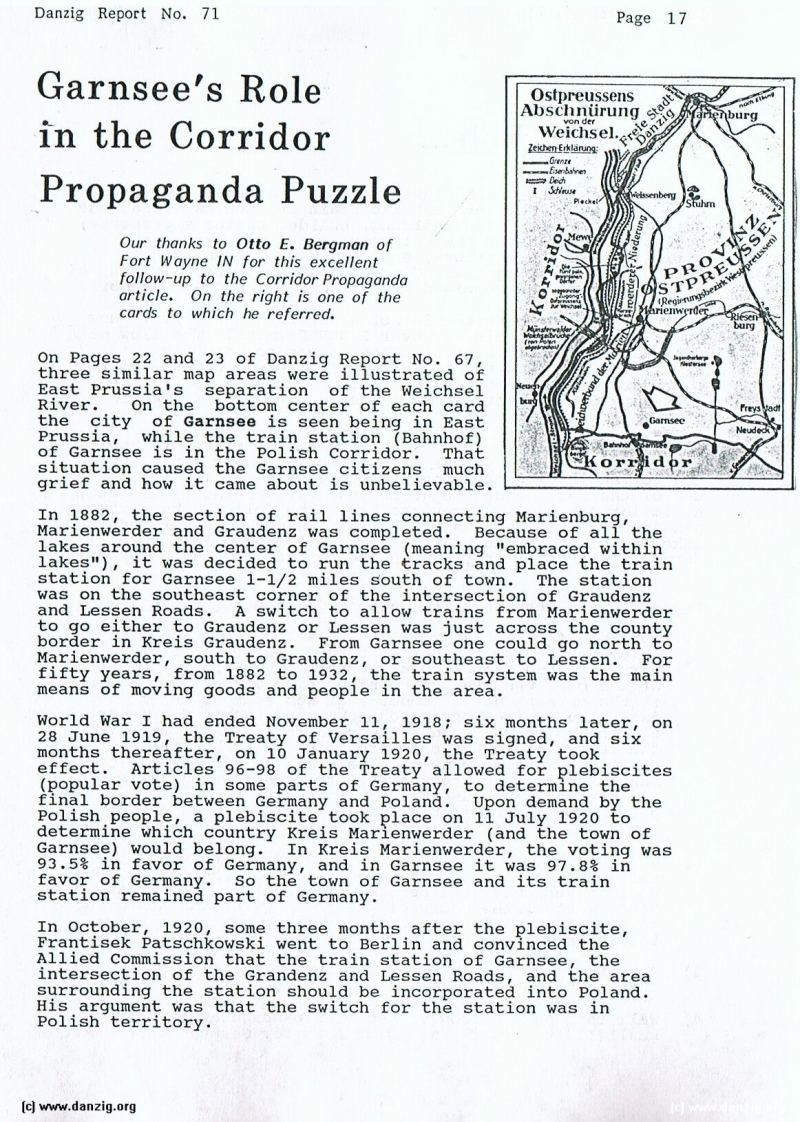
Garnsee’s Role in the Corridor Propaganda Puzzle
Our thanks to Otto E. Bergman of Fort Wayne IN for this excellent follow-up to the Corridor Propaganda article. On the right is one of the cards to which he referred.
On Pages 22 and 23 of Danzig Report No. 67, three similar map areas were illustrated of East Prussia’s separation of the Weichsel River. On the bottom center of each card the city of Garnsee is seen being in East Prussia, while the train station (Bahnhof) of Garnsee is in the Polish Corridor. That situation caused the Garnsee citizens much grief and how it came about is unbelievable.
In 1882, the section of rail lines connecting Marienburg, Marienwerder and Graudenz was completed. Because of all the lakes around the center of Garnsee (meaning “embraced within lakes”), it was decided to run the tracks and place the train station for Garnsee 1-1/2 miles south of town. The station was on the southeast corner of the intersection of Graudenz and Lessen Roads. A switch to allow trains from Marienwerder to go either to Graudenz or Lessen was just across the county border in Kreis Graudenz. From Garnsee one could go north to Marienwerder, south to Graudenz, or southeast to Lessen. For fifty years, from 1882 to 1932, the train system was the main means of moving goods and people in the area.
World War I had ended November 11, 1918; six months later, on 28 June 1919, the Treaty of Versailles was signed, and six months thereafter, on 10 January 1920, the Treaty took effect. Articles 96—98 of the Treaty allowed for plebiscites (popular vote) in some parts of Germany, to determine the final border between Germany and Poland. Upon demand by the Polish people, a plebiscite took Elace on 11 July 1920 to determine which country Kreis Marienwerder (and the town of Garnsee) would belong. In Kreis Marienwerder, the voting was 93.5% in favor of Germany, and in Garnsee it was 97.8% in favor of Germany. So the town of Garnsee and its train station remained part of Germany.
In October, 1920, some three months after the plebiscite, Frantisek Patschkowski went to Berlin and convinced the Allied Commission that the train station of Garnsee, the intersection of the Grandenz and Lessen Roads, and the area surrounding the station should be incorporated into Poland. His argument was that the switch for the station was in Polish territory.
Danzig Report Vol. 1 - Nr. 71 - April - May - June - 1991, Page 17.
Hits: 3495
Added: 30/06/2015
Copyright: 2025 Danzig.org

